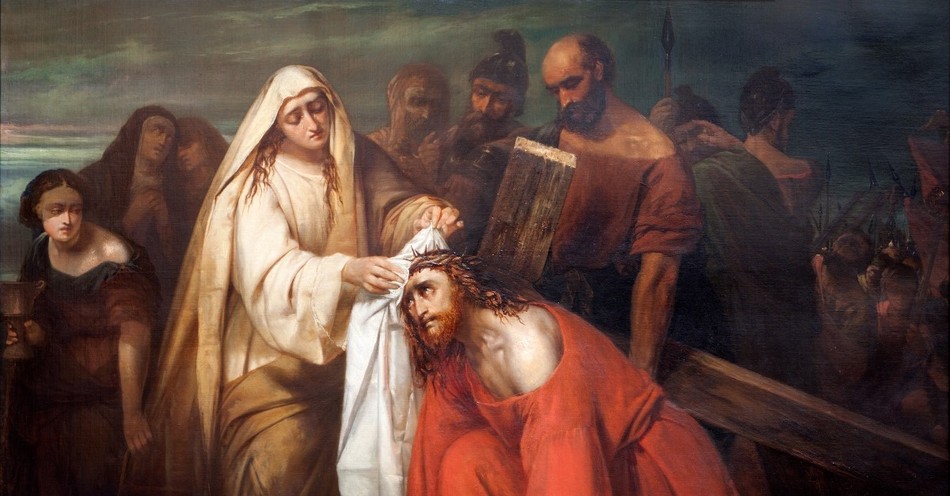Many of us have heard of the woman with the bleeding problem in Mark 5. For those who don’t know this woman’s story, she has been dealing with a problem of bleeding (period blood) for most of her life. Doctors can’t help her. One day, Jesus passes by to resurrect a man’s daughter. She touches the hem of his cloak and experiences instant healing.
In the biblical narrative, that’s where her story ends. But church tradition has her doing a few other things. Church history also knows her by the name Saint Veronica. Let’s dive into what church tradition says about Saint Veronica and what we can learn from her story.
Disclaimer: While other traditions discuss St. Veronica as a historical church figure, evangelical Christians do not uphold this tradition. Readers are encouraged to use this article as an introduction to conversations about church tradition.
Saint Veronica's Veil
For those unfamiliar with the stations of the cross, some church traditions claim that 14 things happened on the way to Jesus’ crucifixion. We can see some of these events in the biblical narrative, such as Simon of Cyrene helping Jesus carry the cross.
Saint Veronica shows up at the sixth station of the cross. When Jesus passes her by, she wipes the face of Jesus on the way to Calvary. We have to imagine that he was a sweaty and bloody mess. He had lost a lot of body fluids during the torture process that preceded his death (some crucifixion victims bled out from flogging before they even reached the crosses). The miraculous event involving the veil occurred when Saint Veronica, moved by compassion, approached Jesus as He carried His cross to Golgotha. She used her veil to wipe the sweat and blood from His face. In return for her act of kindness and bravery, it is said that Jesus left an imprint of His face on the cloth. This image on the veil is not just seen as a miraculous sign but also as a direct artifact of Christ's suffering and Veronica's compassion.
Theologically, the act of Saint Veronica wiping Jesus' face and the resulting image on her veil are profoundly meaningful. From an evangelical Christian viewpoint, this story highlights the importance of mercy and personal sacrifice, showing that compassionate actions can lead to encounters with the divine. The image on the veil acts as a powerful reminder of God's presence and involvement in our lives. It also represents the idea that serving others, particularly in their times of need, is a vital expression of faith and can lead to spiritual insights. This teaches believers to see Christ in everyone and to treat others with kindness, as Veronica did, with the assurance that such deeds are noticed and blessed by God.
According to tradition, the imprint of Jesus’ face was left Veronica's veil, becoming a holy relic. This same cloth may be kept in the Vatican archives today.
The veil also supposedly had some miraculous powers, as the traditions of certain church relics go. It supposedly healed Emperor Tiberius when he was ill.
What Does the Name Veronica Mean?
The name Veronica means “true image.” In other words, Saint Veronica, in tradition, received the true image of Christ on the veils which she used to wipe his face.
Some other variations of Veronica can come from the name Bernice, which means victory. However, the only mention of a woman named Bernice in the Bible lives in infamy.
Based on the first interpretation of Veronica’s name, we can see names in the Bible aren’t without irony. Names can often tell us about what a person will become or do down the road. Names have an important meaning throughout church history.
What Else Does Church Tradition Say about Saint Veronica?
As mentioned earlier, different Christian traditions debate whether Saint Veronica and the woman with the bleeding problem were the same.
But assuming this tradition is correct, St. Veronica supposedly married the tax collector Zacchaeus (who you probably remember from the Sunday school song). She also carried several relics, including ones that belonged to Jesus’ mother, to locations in modern-day France. Zacchaeus eventually becomes a hermit during their missions work in Rome. St. Veronica then assists a preacher named Martial.
History is not forthcoming about how St. Veronica died. Apart from a few apocryphal documents, we don’t have much about her. The story about her focuses on her compassion for Jesus at the cross, followed by her carrying relics to various places.
We can assume that because she was not known for her martyrdom, she perhaps died of natural causes instead of murder. The Roman Catholic church has a feast day commemorating her life and service.
What Is the Earliest Reference to St. Veronica?
If we exclude the mention of the woman with the bleeding issue in Mark, we are not left with many early documents about St. Veronica.
Perhaps the earliest is Historia Ecclesiastica by Eusebius. We get most of our information from this document—although, since it was written in the fourth century, it’s hard to say how much is history and how much is legendary.
Another source in which we learn about her comes from the apocryphal Acts of Pilate. From this, we first learn of her name. Supposedly, Pilate and his wife became Christians after the death and resurrection of Jesus.
We should mention that all of these texts listed are not scriptural canon and were written several centuries after the events took place. Although they can be interesting reads, we should read with discernment. Although, I will say I would love to believe that St. Veronica and the woman with the bleeding problem are the same. And that she had married Zacchaeus and contributed to the early efforts of the early church.
Whether the documents listed above are accurate or not, the figure of St. Veronica can have a lot to teach us as we go about our daily lives. Furthermore, any figure in the Bible (or saint from church history) can provide some personal applications for our lives today.
Is Saint Veronica Celebrated Today?
Saint Veronica does not have a universally fixed feast day in the Roman Catholic calendar, as her veneration varies significantly among different Christian traditions. While not widely celebrated with a specific feast day in the Roman Catholic Church since the liturgical reforms of the 1960s, she remains a figure of devotion in many communities, particularly those that deeply engage with the Stations of the Cross, where her act of compassion is commemorated.
In some places, her legacy is honored on July 12th, but this is not consistent across all branches of Christianity. Despite the variations in liturgical recognition, Saint Veronica's story continues to inspire many Christians around the world, particularly for her role in the sixth Station of the Cross during Lenten observances. Her story of compassion and the miraculous image are often highlighted in religious art, processions, and prayers, keeping her memory alive in the practices and devotions of the faithful.
Can the Story of Saint Veronica Teach Us Anything?
Indeed St. Veronica can teach us a great deal. However, we will boil it down to three major applications that we can take away from this saint.
First of all, miraculous healings provide an enormous testimony.
If tradition holds up, St. Veronica truly is the woman with the bleeding issue, she would’ve spent years in frustration. Scripture says she spent all her savings on doctors who couldn’t help her. As someone with an autoimmune disease, I can relate hardcore to her and the lack of attention women can receive in the medical system.
Through faith, she believes that she will receive healing if she even touches the hem of Jesus’ cloak. And indeed, just that happens.
Second of all, compassion breeds compassion.
When we experience the loving-kindness of the Lord, we cannot help but “spread the wealth.” If Christians have truly experienced joy and healing in Christ, we should see it in their actions. It makes sense that St. Veronica would not hesitate to help Jesus on the way to Golgotha.
When the rest of Jesus’ disciples scattered, for fear that association with Jesus could get them killed too, St. Veronica stepped up to the task. For even a brief moment, she provided relief for Jesus. He could not wipe the blood and sweat off as he was about to be nailed—naked—to the cross.
Because of this act, St. Veronica supposedly received a relic that could provide healing for others. First, she was healed. Now others, through the power of Christ, could receive the same.
Finally, women had multiple roles in the early church.
In church culture, we’ve often told women to take a backseat and let the men lead. Even certain books (that will go unnamed for not throwing authors under the bus) have suggested that when a woman serves, it bruises men’s egos. As if for men to step up, we need to push back half of the population in a church.
The early church didn’t seem to work like this. St. Veronica goes on missions with her husband. She helps to preach alongside a man she isn’t married to. She helps heal emperors and spread the Gospel.
Although we can take certain traditions with a grain of salt, we need to realize that God has created all of us for more than one role. And that callings can look different.
Saint Veronica went from being a woman who had trouble getting out of bed to being someone who forwarded the Gospel. May we have the chance to learn a lot from her.
Photo Credit: Getty Images/sedmak
Hope Bolinger is an acquisitions editor at End Game Press, book editor for hire, and the author of almost 30 books. More than 1500 of her works have been featured in various publications. Check out her books at hopebolinger.com for clean books in most genres, great for adults and kids. Check out her editing profile at Reedsy.com to find out about hiring her for your next book project.

.jpg)

.jpg)
